A photo from Guatemala have also been included, as this has recently become an operating center for Mexican drug cartels.
See also:
Mexico Drug Cartel Carnage Photos
 Police officers inspect the scene where the bodies of four men were dumped by the side of the Mexico City-Acapulco highway near Cuernavaca, Mexico, Sunday, Sept. 26, 2010. A warning message was left next to the bodies, signed by the Southern Pacific drug cartel.(AP Photo/Antonio Sierra) |
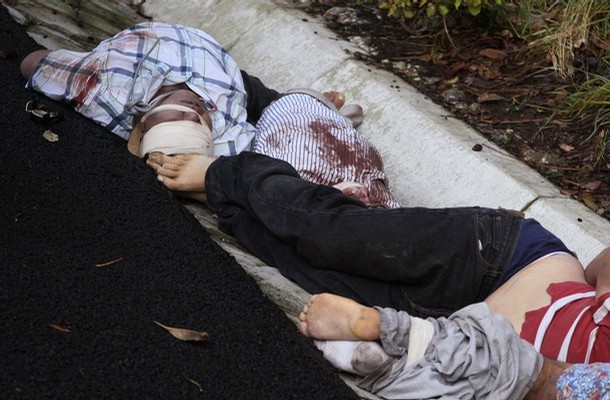 The bodies of four dead men lie on the side of the Mexico-Cuernavaca highway September 26, 2010. The men, handcuffed and with signs of torture, were dumped next to the highway and with a message from Pacific Cartel accusing them of being car thieves, according to local media. REUTERS/Margarito Perez |
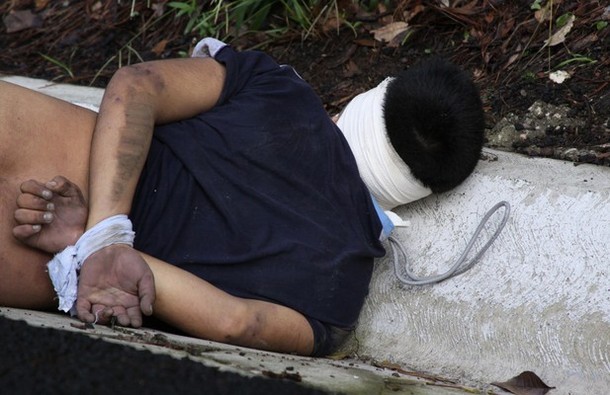
The body of a man is seen on the side of the Mexico-Cuernavaca highway September 26, 2010. Four men, handcuffed and with signs of torture, were dumped next to the highway and with a message from Pacific Cartel accusing them of being car thieves, according to local media. REUTERS/Margarito Perez
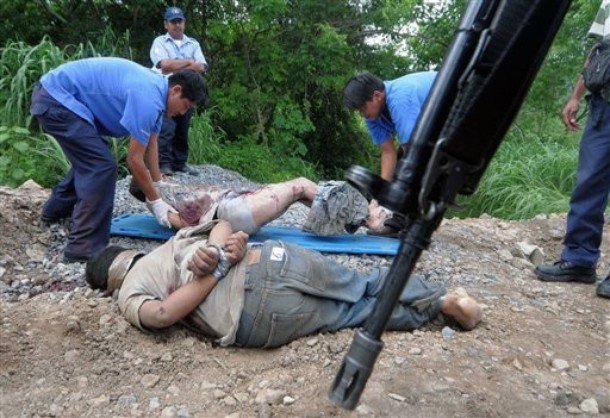 Workers carry onto stretchers the bodies of two men found near a road on the outskirts of Acapulco, Mexico, Friday, Aug. 27, 2010. Several separate violent incidents in this Pacific resort city have left more than a dozen dead in less than 24 hours. (AP Photo/Bernardino Hernandez) |
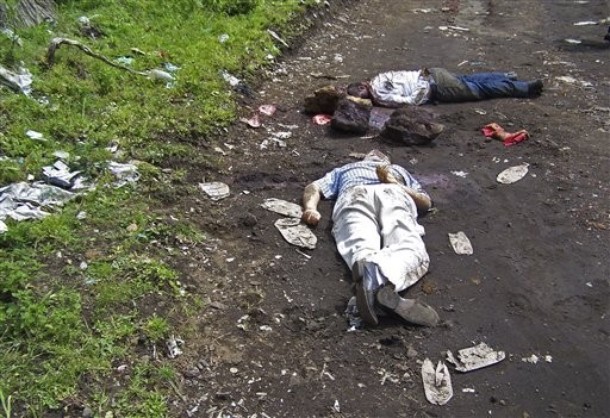 The bodies of Gustavo Sanchez, mayor of the small town of Tancitaro, Mexico, and aide Rafael Equihua lie face down on a road near the town of Uruapan, Mexico, Monday Sept. 27, 2010. According to a spokesperson for the Michoacan state attorney general, the men were stoned to death. (AP Photo/Agencia Quadratin) |
 A soldier stands guard on the roof of the house where, according to Mexico's Defense Ministry, a top leader of the Sinaloa cartel, Ignacio Coronel Villareal, aka Nacho, was killed in Guadalajara, Mexico, Friday July 30, 2010. Soldiers killed Coronel on Thursday in a raid on his posh hideout, dealing the biggest blow yet to Mexico's most powerful drug gang since President Felipe Calderon launched a military offensive against organized crime in 2006. (AP Photo/Claudio Cruz) |
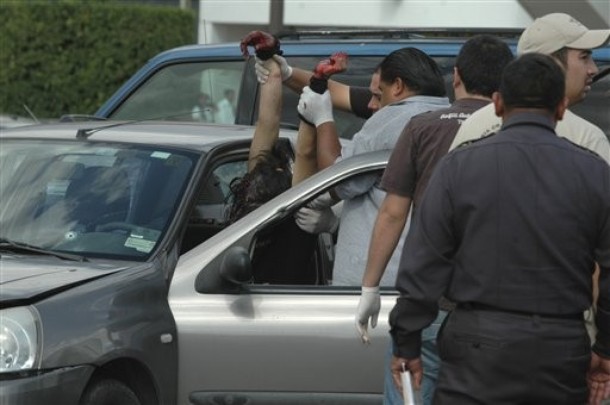 Crime scene investigators remove the body of photojournalist Luis Carlos Santiago, who works for Diario de Juarez newspaper, from his car at a shopping mall parking lot in the northern border city of Ciudad Juarez, Mexico, Thursday Sept. 16, 2010. Santiago, 21, who started working at the newspaper two weeks ago, and fellow photojournalist Carlos Sanchez, an intern, were attacked as they left their offices, according to Diario de Juarez news director Pedro Torres. Sanchez was seriously wounded. (AP Photo/Raymundo Ruiz) |
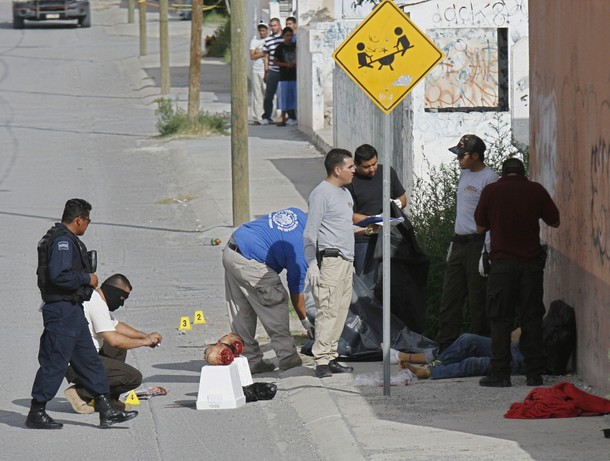
Police check two decapitated bodies found on a street of Ciudad Juarez, Chihuahua state, Mexico on July 28, 2010. The beheaded bodies of the youths were found in a residential area of Ciudad Juarez, accompanied by a message that identified them as "extortionists linked to La Linea," a group of gunmen linked to the Juarez cartel, Chihuahua prosecutors said. AFP PHOTO/STR
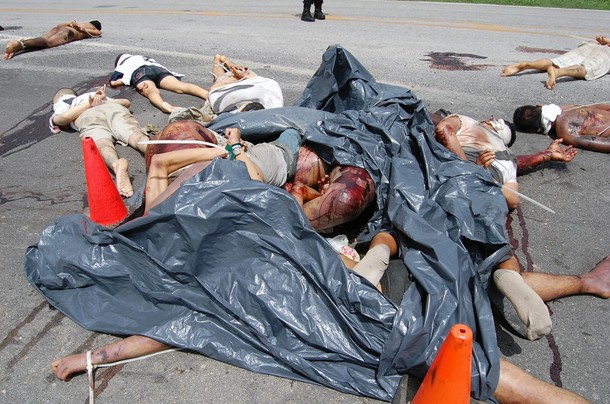 Some 15 bodies found along a road in Tamaulipas State in Mexico on July 29, 2010. The bodies were found on a highway leading from Ciudad Victoria to Matamoros, not far from the US border city of Brownsville, Texas. Officials said the victims had "their hands tied, their eyes blindfolded and bore visible signs of torture" including obvious head injuries, said the official, who declined to be identified. AFP PHOTO |
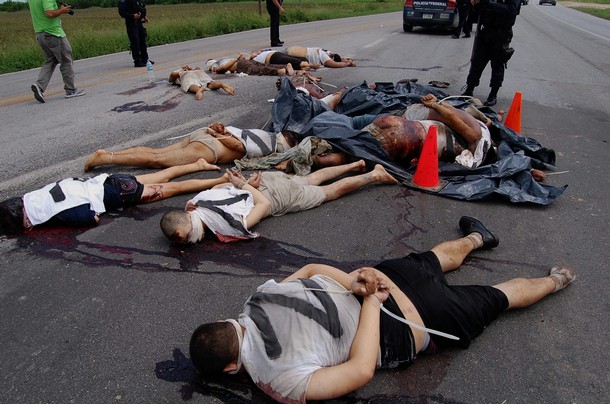 Some 15 bodies found along a road in Tamaulipas State in Mexico on July 29, 2010. The bodies were found on a highway leading from Ciudad Victoria to Matamoros, not far from the US border city of Brownsville, Texas. Officials said the victims had "their hands tied, their eyes blindfolded and bore visible signs of torture" including obvious head injuries, said the official, who declined to be identified. AFP PHOTO |
 Federal police present an alleged drug cartel member to the press in Mexico City, Friday Aug. 13, 2010. Five alleged members of La Linea drug cartel, accused of participating in the killings of two federal police officers, were arrested Thursday in the border town of Ciudad Juarez, according to the police. (AP Photo/Alexandre Meneghini) |
 Federal police present an alleged drug cartel member to the press in Mexico City, Friday Aug. 13, 2010. Five alleged members of La Linea drug cartel, accused of participating in the killings of two federal police officers, were arrested Thursday in the border town of Ciudad Juarez, according to the police. (AP Photo/Alexandre Meneghini) |
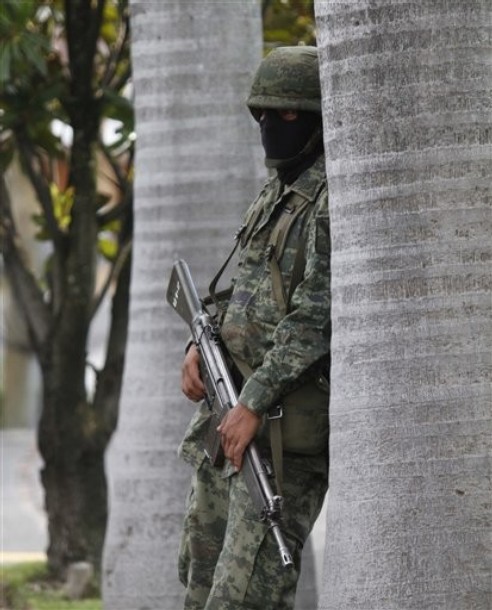 A soldier guards a street in the area where, according to Mexico's Defense Minister, Mexican drug cartel leader Ignacio Coronel Villareal, aka Nacho Coronel was killed during an army raid in Zapopan, near Guadalajara, Mexico, Thursday July 29, 2010. Coronel is considered number three in the organization of fugitive Mexican drug lord Joaquin Chapo Guzman. (AP Photo/Claudio Cruz) |
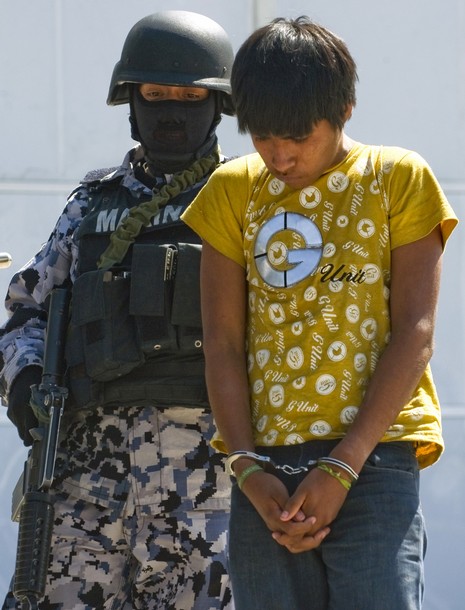 A member of the drug gang "El Cartel del Golfo" (The Gulf Cartel) is shown to the press before a hangar of the Mexican Navy in Mexico City on September 29, 2010. Thirty members of the gang were detained in Tamaulipas State on Tuesday. AFP PHOTO/Alfredo Estrella |
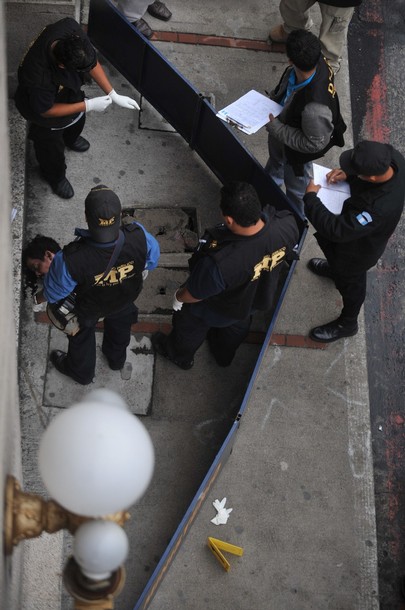 Forensic personnel inspect a human head found in front of Congress building in downtown Guatemala City, June 10, 2010. At least three severed human heads and equal number of beheaded bodies where found Thursday in different places of the Guatemalan capital together with intimidatory messages addressed to Interior Ministry and penitentiary personnel. AFP PHOTO Johan ORDONEZ. |
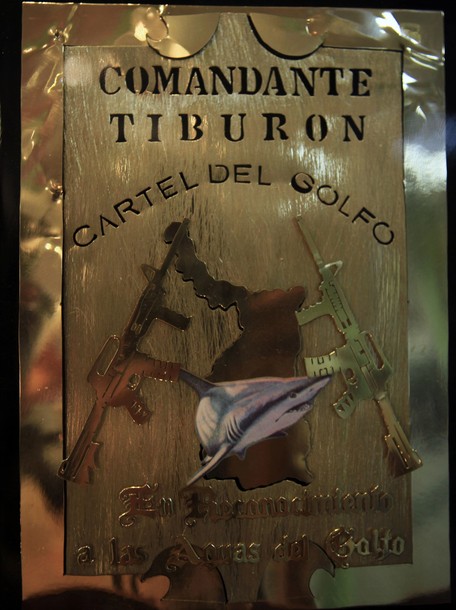 A plate of the Golfo drug cartel is displayed in the Drugs Museum at the headquarters of the Mexican Ministry of Defense in Mexico City August 18, 2010. The Virgin of Guadeloupe sculpted in the handle of a gun, high precision rifles, a mobile phone with diamond and gold incrustations, clandestine laboratories for drug processing and many more items that once belonged to drug traffickers are displayed in this private museum used by the military to show the soldiers the lifestyle of the Mexican drug lords. REUTERS/Eliana Aponte |
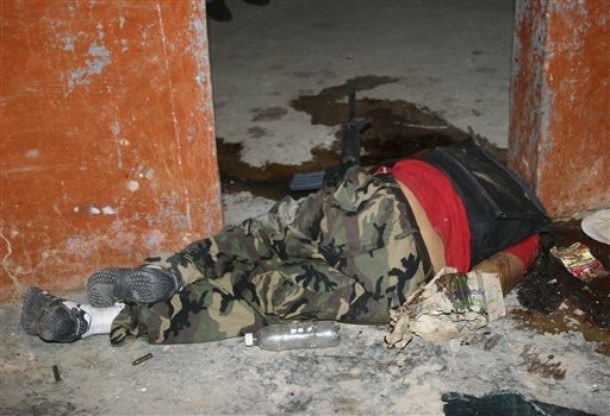
A man, wearing military fatigues, lies dead after an army raid near Ciudad Mier, in northern Mexico, near the U.S. border, Thursday, Sept. 2, 2010. Soldiers killed at least 25 suspected cartel members after troops moved in the area where a military aircraft spotted several gunmen in front of a building. Authorities said three people believed to be kidnap victims were rescued in the raid. (AP Photo)
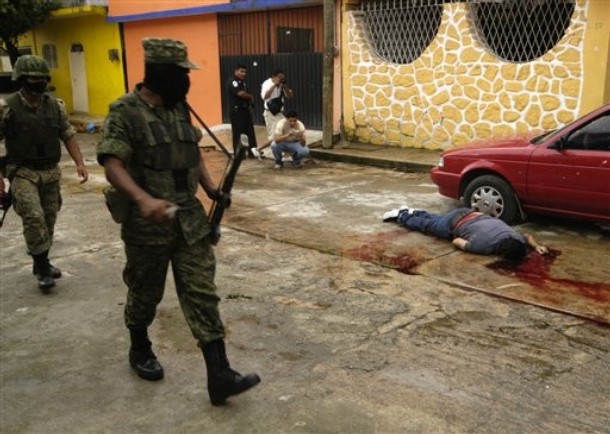 Army soldiers walk by the body of a man lying in the street in Acapulco, Mexico, Thursday Sept. 23, 2010. Authorities say seven people were killed in a shootout between rival drug gangs. (AP Photo/Bernandino Hernandez) |
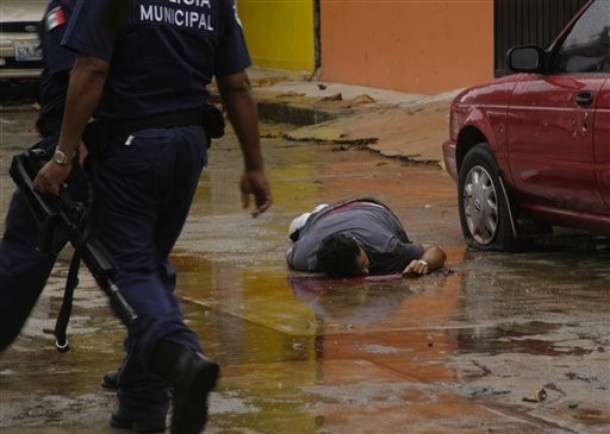 Municipal police walk by the body of a man lying on the street by a car riddled with bullet holes in Acapulco, Mexico, Thursday Sept. 23, 2010. Authorities say seven people were killed in a shootout between rival drug gangs. (AP Photo/Bernandino Hernandez) |
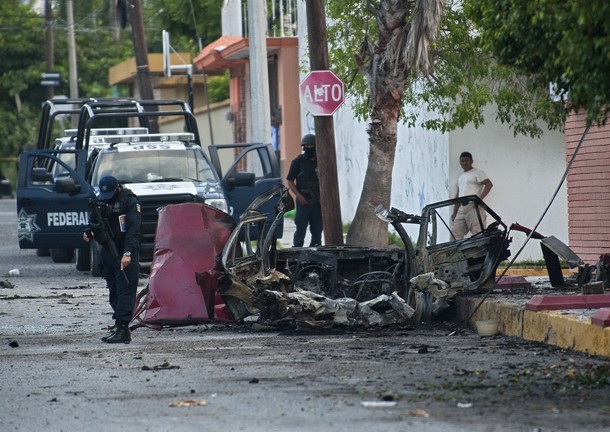
A burned car is pictured in front of Televisa TV network after a car bomb exploded with no casualties, early Friday in the northeastern city Ciudad Victoria, Tamaulipas state on August 27, 2010. The Gulf of Mexico drug cartel has been engaged in a bitter turf war for control of Tamaulipas smuggling routes into the United States with the Zetas drug cartel. AFP PHOTO/Ronaldo Schemidt
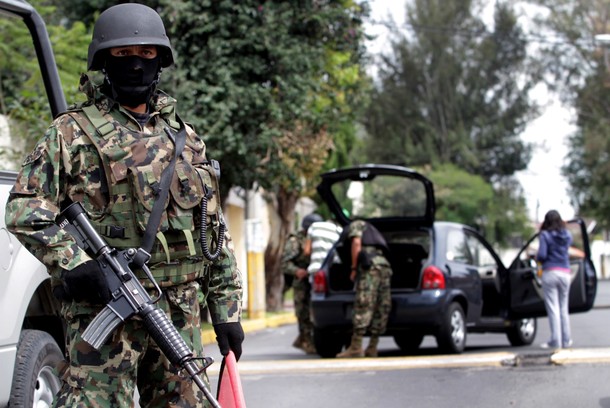 Mexican marines check a vehicle as another stands guard on a street on the outskirts of Puebla September 12, 2010. Mexican marines captured Sergio Villarreal, dubbed 'El Grande', a top lieutenant of a leading drug cartel, on Sunday as authorities intensified their campaign against drug kingpins, local media reported. REUTERS/Stringer |
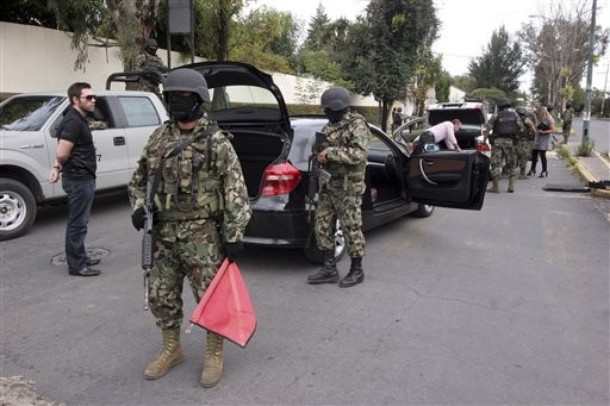 Navy marines guard a roadblock at the entrance to the residential compound where the alleged drug kingpin Sergio Villareal Barragan, alias "El Grande," was arrested in Puebla, Mexico, Sunday Sept. 12, 2010. Mexican marines captured Villarreal, a presumed leader of the embattled Beltran Leyva cartel who appears on a list of the country's most-wanted fugitives, in a raid Sunday, the government said. (AP Photo) |
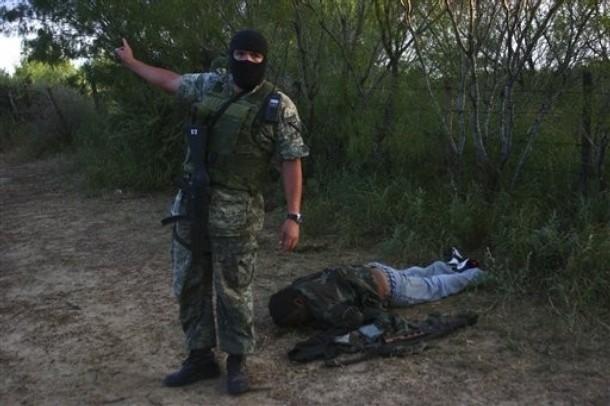
An army soldier stands next to a dead gunman, wearing military fatigues, after a raid and gun battle on the vicinity of Ciudad Mier, northern Mexico, near the U.S. border, Thursday, Sept. 2, 2010. Soldiers killed at least 25 suspected cartel members after troops moved in the area where military aircraft spotted several gunmen in front of a building. Authorities said three people believed to be kidnap victims were rescued in the raid. (AP Photo)
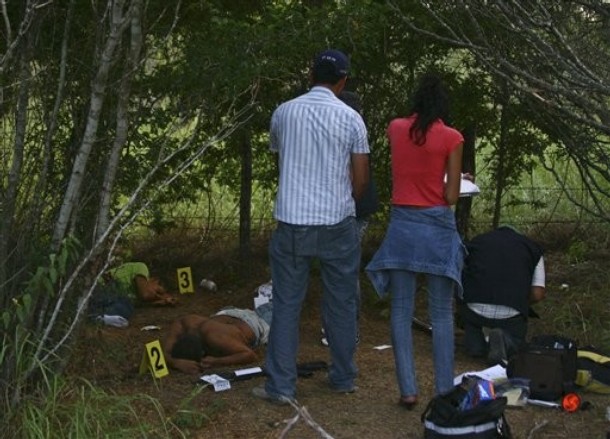
Crime scene investigators survey the area where bodies lie after a raid and gun battle on the vicinity of Ciudad Mier, northern Mexico, near the U.S. border, Thursday, Sept. 2, 2010. Soldiers killed at least 25 suspected cartel members after troops moved in the area where military aircraft spotted several gunmen in front of a building. Authorities said three people believed to be kidnap victims were rescued in the raid. (AP Photo)
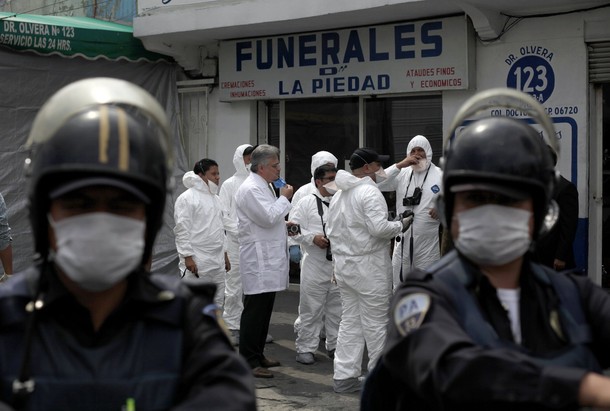 Mexican policemen stand guard as members of a forensic team gather outside a mortuary where 56 bodies will be embalmed in Mexico City September 1, 2010. Mexican marines found 72 corpses at a remote ranch near the U.S. border, the Mexican navy said on August 24. The marines came across the bodies of 58 men and 14 women, thought to be migrant workers, last week at the ranch in Tamaulipas state, 90 miles (145 km) from the Texas border, after a series of firefights with drug gang members. REUTERS/Eliana Aponte |
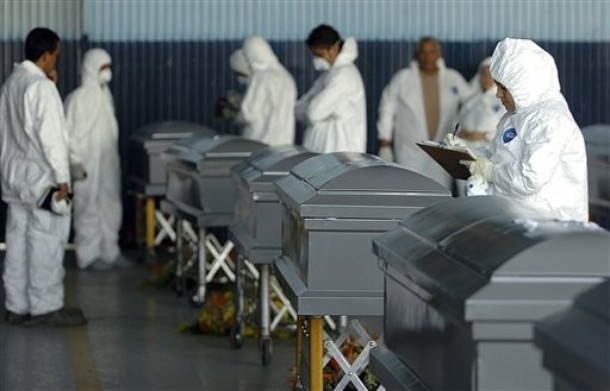 Forensic experts inspect the coffins containing the remains of 16 Hondurans who were killed in Mexico while trying to reach the U.S. border, before returning the bodies to family members in Tegucigalpa, Honduras, Wednesday Sept. 1, 2010. The bodies of 72 Central and South American migrants, who were allegedly killed by a Mexican drug cartel, were found within 100 miles of the U.S. border on Aug. 24. (AP Photo/Fernando Antonio) |
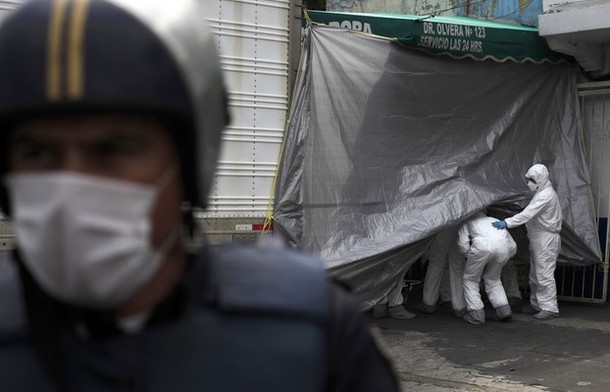
A Mexican police officer stands guard as members of a forensic team enter a mortuary where 56 bodies will be embalmed in Mexico City September 1, 2010. Mexican marines found 72 corpses at a remote ranch near the U.S. border, the Mexican navy said on August 24. The marines came across the bodies of 58 men and 14 women, thought to be migrant workers, last week at the ranch in Tamaulipas state, 90 miles (145 km) from the Texas border, after a series of firefights with drug gang members. REUTERS/Eliana Aponte
Share this:































